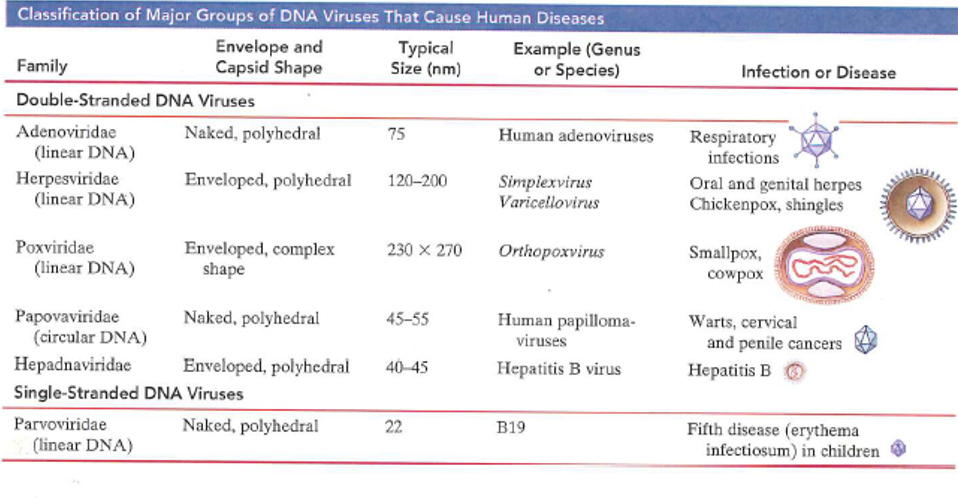intro to virology
...
VIRUSES
- NOT "living" organisms
- NOT cells
- no nucleus, organelles, or cytoplasm
- are subcellular infectious agents
- replicated only inside living host cells
- if outside of a cell, they are only complex nucleoprotein particle - doesnt do anything outside cell
- = is OBLIGATE intracellular parasite bc it needs to be in the cell to function
viruses not the only obligatory intracellular parasites known
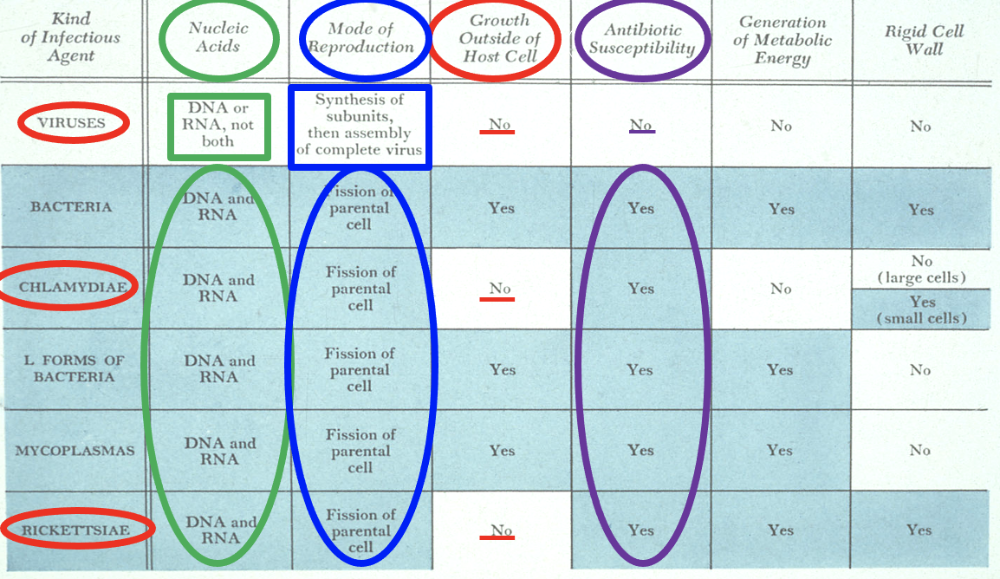
- other unicellular organisms, some bacterial species, some protozoa can multiple only inside other host cells
-
nucleic acid
- viruses have EITHER DNA or RNA - NEVER BOTH
- why theyre unique
-
mode of reproduction
- synthesis of subunits, then assembly of complete virus
- while bacteria do fission, etc.
-
growth outside host cell
- NO, viruses cannot
-
antibiotic susceptibility
- NO
definition and properties of a virus
- viruses are filterable agents
- obligate intracellular parasites
- cannot make energy or proteins independent of host cell
- viral components are assembled and do not replicate by "division"
- viral genomes may be RNA or DNA but NOT BOTH
- viruses have a naked capsid OR envelope morphology
consequences of viral properties
- viruses are not living
- viruses must be infectious to endure in nature
- viruses must be able to utilize the host cell processes to produce their components (viral mRNA, protein, identical copies of the genome)
- viruses must encoded any required process not provided by the cell
- viral components must self-assemble
viruses probably evolved over several billion years + affected ppl since ancient times
- nature of viruses only beginning to be understood by end of XIX century
- realized that infectious diseases were transmitted by air, water, food, or close contact to sick ppl caused by mysterious elements in fluids called virus
- had ppl w rabies and didnt know what it was
- had ppl w polio and didnt know what it was
...
effective vaccines against smallpox and rabies developed in 1798 and 1995
- BUT no clear understanding of the nature of these disease
agents, which are know now as viruses
- didnt understand, just know some things were working
- end of XIX, russian scientist and dutch scientist independently showed that agent that caused tobacco mosaic disease could passn through fine earth or porcelain filters which retain bacteria
- VIRUSES WERE FIRST DISTINGUISHED FROM OTHER MICROORGANISMS BY FILTRATION
- afterwards, similar experiments carried out on agents that cause foot and mouth disease in cattle + yellow fever in humans
- experiments established that certain infectious agents are much smaller than bacteria - called filterable viruses
using filtration as diagnostic tool -> many viruses were discovered in first half of XX century
- 1st tumor virus (RVS, rous sarcoma virus) isolated from sarcomas of chicken in 1911
- years later -> RSV recognized as representative of retrovirus family
- RSV virus which existance of oncogenes was discovered
- wendell stanley
found that purified tobacco mosaic virus could form
crystals
- shocked scientific world bc placed viruses at edge btw living organisms and chemical compounds
- posed question: are viruses living or inanimate???
- CRYSTALLIZATION OF TOBACCO MOSAIC VIRUS CHALLENGED CONVENTIONAL NOTIONS ABOUT GENES AND NATURE OF LIVING ORGANISMS
- Show many properties of life ONLY when inside cell (given means to support replication) because they have ability to mutate, evolve, etc
WE NOW KNOW: VIRUSES ARE INANIMATE WHEN THEIR GENOMES PACKAGED IN VIRIONS
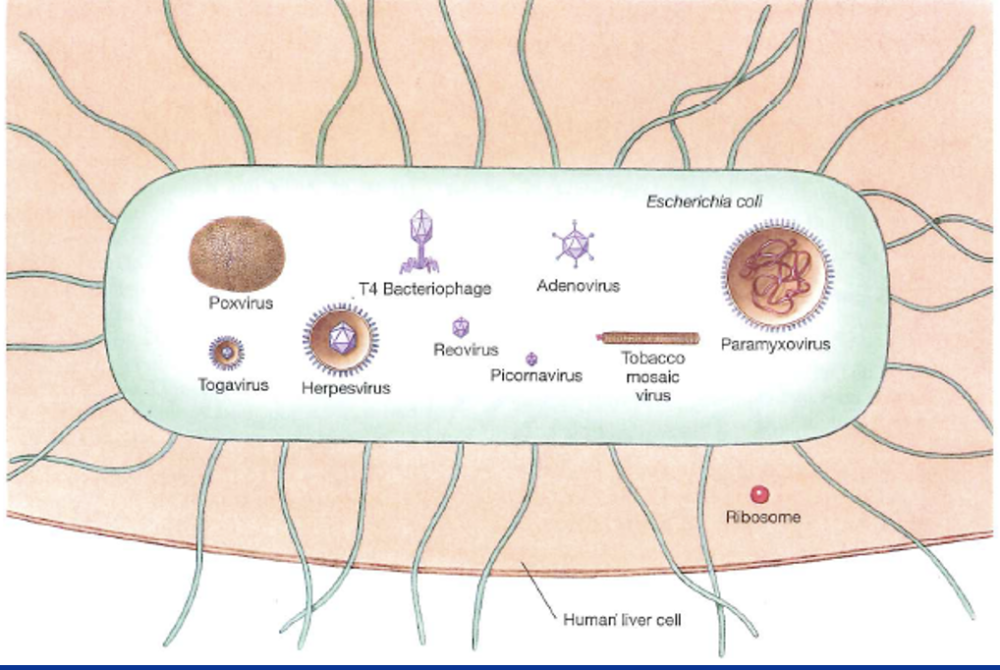
- they do share many properties of life:
- ability to mutate, evolve, reproduce themselves when enter cells that support their replication
- stanley and others showed that viruses contain both protein and nucleic acids
- at the time, it was still not known that genes were made up of nucleic acids
- dev of electron microscope allowed scientists to see viruses for first time (1930s)
possible origins of viruses
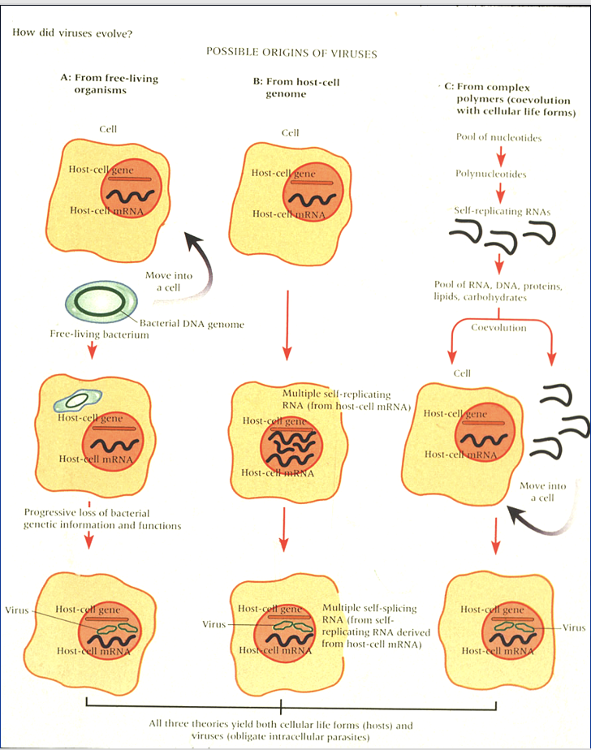
virion components
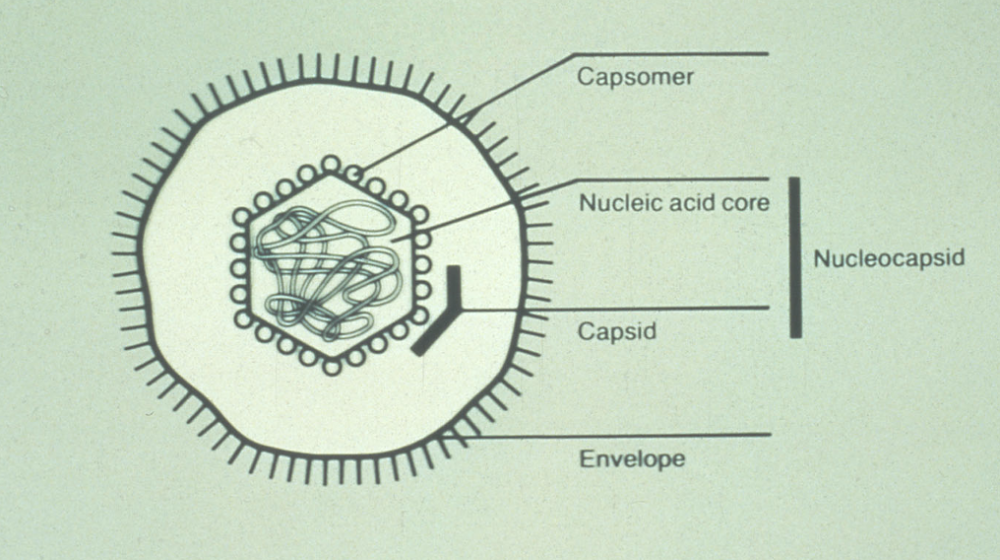
Simplest virus
- nucleaic acid (DNA or RNA – NEVER both) – made of proteins
- capsid
- nucleocapsid – capsid + nucleic acid core
- envelope
- capsomer
what goes into naked capsid virus and enveloped virus
NAKED CAPSID VIRUS
- nucleocapsid
- DNA OR RNA
- structural proteins
- (possibly/sometimes) enzymes and nucleic acid binding proteins
ENVELOPED VIRUS
- nucleocapsid
- glycoproteins and membrane
nucleic acid process
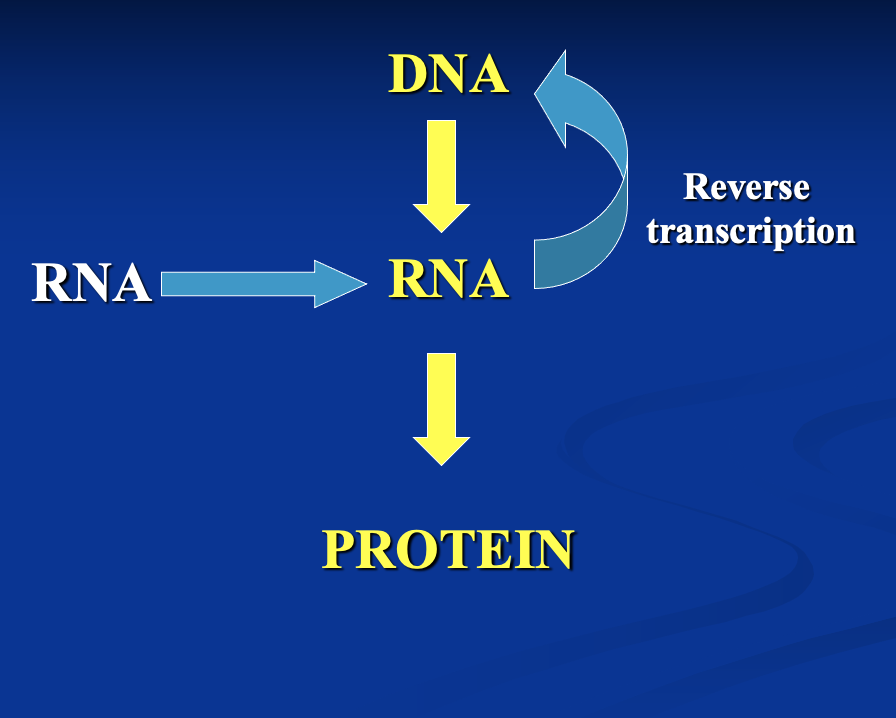
- some use reverse transription enzyme
- make DNA from RNA to make more RNA
viral nucleic acid characteristics
- single vs double stranded
- segmented vs nonsegmented
- linear vs circular
- positive vs negative stranded vs ambisense
enzymes in viral replication
- DNA dependent DNA polymerase
- DNA dependent RNA pol
- RNA dependent RNA pol
- RNA dependent DNA pol
- viral encoded vs carried within viral particle
- Some are encoded by only the virus. Others, the virus must carry it within the viral particle
Additional concepts
-
defective viruses are:
- viruses which lack complete genome so they cant completely replicate / cannot form a protein coat
- able to replicate only when their genetic defect is complemented by a helper virus
- abortive infections: failed infections of a cell
- nonpermissive cells will not allow replication of a particular type or strain of virus
- permissive cells provide the biosynthetic machinery to support the complete replicative cycle of the virus
viral capsid symmetry
only 2 types of symmetry are present in viral capsids
- cubic symmetry (icosahedron)
-
helical symmetry
- Helical configuration Circles inside = nucleic acid Circles outside = capsomeres that cover and give helical configuration For viruses that infect HUMANS: Those that have helical configuration all have outer envelope
- viruses (ex: poxvirus) can be neither
cleavage of viral proteins
After cleavage of long protein = protomers –> assemble in pentamers (capsomers)
Example: polio virus – original protein cleaved into 4
= how get mature virus form
Naken capsid virus can become envelope virus
Only thing inside = structural protein = matrix protein
Then lipid bilayer (outer membrane from host cell)
Then glycoprotein – must have so can have receptor proteins
This shows same thing but has example of enveloped and naked capsid
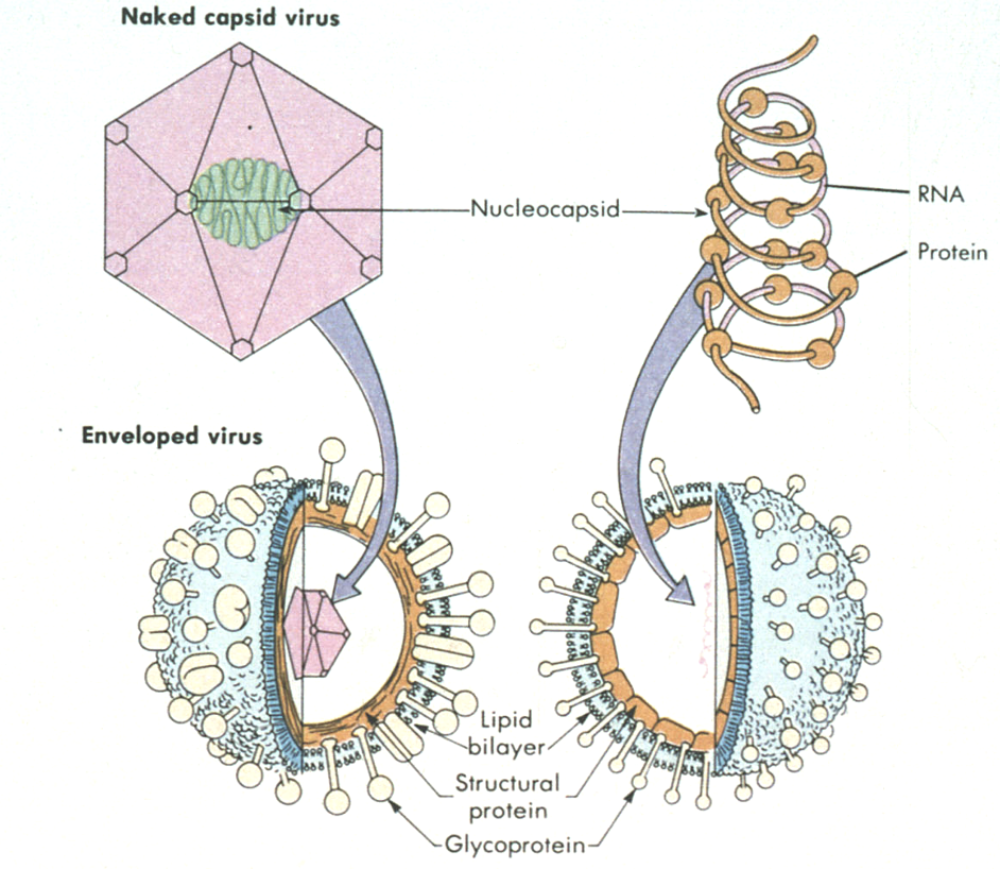
virus structure: naked capsid
Naked capsid – only protein structure
components - protein
properties
- environmentally stable to:
- temperature
- acid
- proteases
- detergents
- drying
- released from cell by lysis
consequences
- spread easily (on fomites, hand to hand, dust, droplets, etc.)
- can dry out and retain infectivity
- can survive the adverse conditions of the gut
- can be resistant to detergents and poor sewage treatment
- can elicit a protective antibody response
Released from cell when complete replication by lysing host cell
- spread easily
- fomites – inanimate thing (table, etc.)
- can dry and still be infected (does not inactivate them)
- survive conditions in gut
– resist detergent and sewage treatment if not good
- elicit usually protective antibody response
virus structure: enveloped
components
- proteins
- membrane
- lipids
- glycoproteins
properties
- environmentally disrupted by
- acid
- detergent
- drying
- heat
- modify cell membrane during replication
- released by budding and cell lysis
- bud off bc they use membrane of the host cell to gain it
consequences
- must stay wet
- cannot survive GI tract
- spreads in large droplets, secretions, organ or blood transplants
- need not kill cell to spread
- initiates a cell mediated immune response
- antibody and cell mediated immune response may be necessary for protection and control
- pathogenesis often due to hypersensitivity and inflammation initiated by CMI
Enveloped
- membrane, lipids, proteins, glycoproteins = more environmentally susceptible
- they are more affected by things / more easily destroyed
- released by BUDDING from host cell (NOT breaking, like naked virus does)
- cannot survive GI
- must be wet
- don’t need to kill cell (budding off)
- bud off bc they use membrane of the host cell to gain it
- antibody usually necessary for control
- most pathogenesis is due to hypersensitivity / inflammation from cell mediated immunity
subviral pathogens
-
viroids
- contain only RNA
-
prions
- contain only protein
2 other infectious agents that are smaller than viruses
= Subviral pathogens
- viroids (comprised SOLELY of RNA)
And
- prions (contain ONLY protein)
viroids
smallest known pathogens
- naked, circular, single stranded RNA molecules that do not encode protein
- but replicate autonomously when introduced into host plants
-
only infect plants
- can cause economically important disease of crop plants
- some benign
- structure
- circle ss RNA with some pairing btw complementary bases and loops where no such pairing occurs
Mostly host plants
There is 1 human infectious agent – is “viroid like” - is not truly a viroid but has many similarities
viruses, viroids, prions
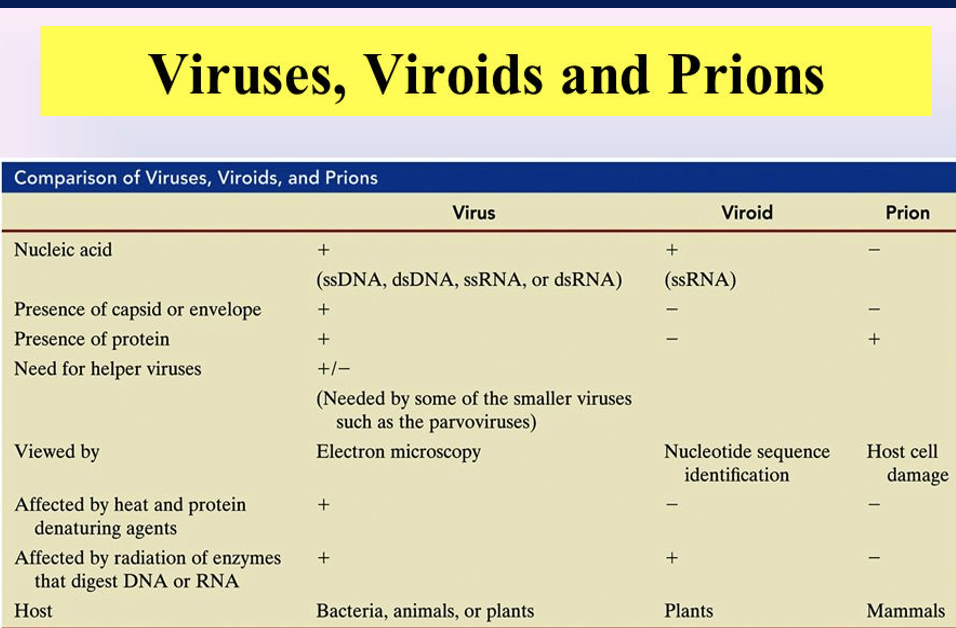
similarities, diffs, comparison
- viruses and viroids have nucleic acid
- viruses can have either type of nucleic acid
- viroid only ssRNA
- prion have neither (no nucleic acid)
Protein present in virus and prions (only thing they have in common)
Important slide
classifications of naming viruses
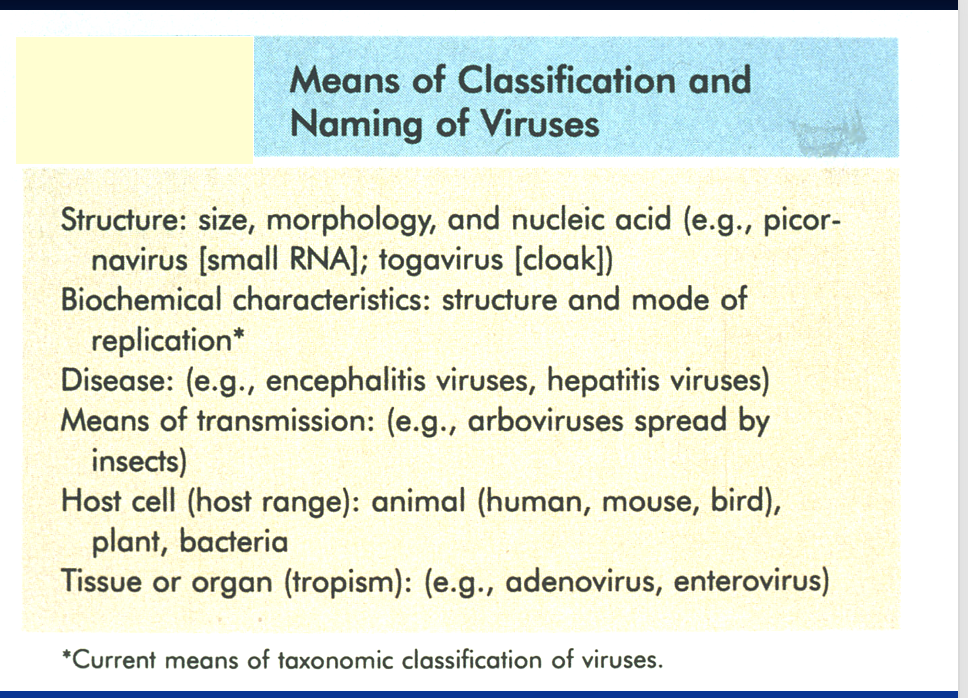
baltimore classification of viruses
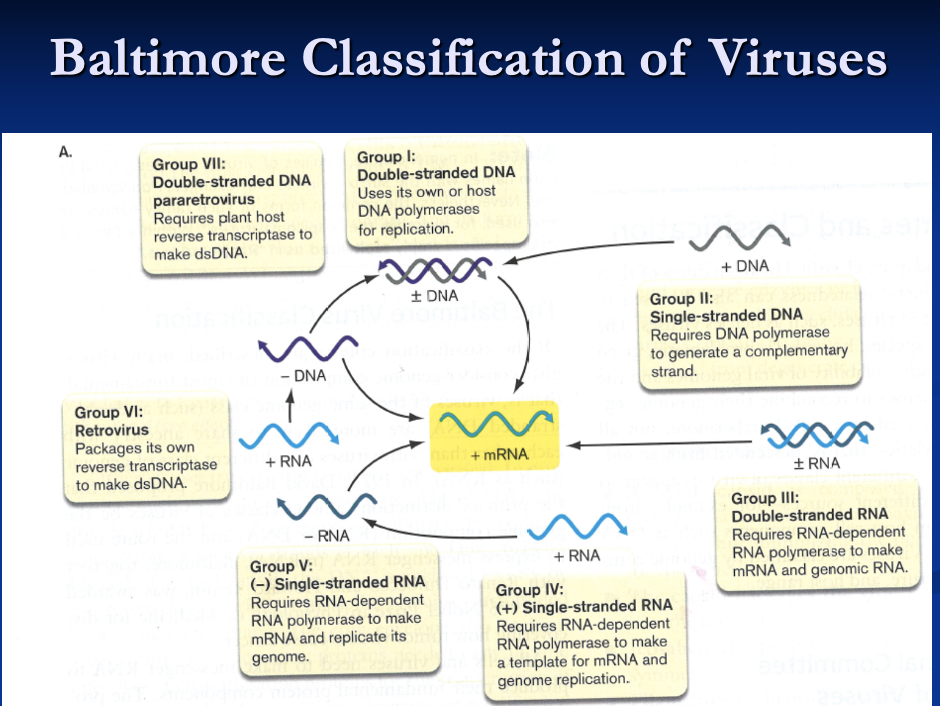
1. DS DNA
- uses own / host DNA polymerases for replication
2. + SS DNA
- requires DNA polymerase to generate complementary strand
3. DS RNA
- requires RNA dependent RNA polymerase to make mRNA and genomic RNA
4. + SS RNA
- requires RNA dependent RNA polymerase to make a template for mRNA and genome replication
5. - SS RNA
- requires RNA dependent RNA polymerase to make mRNA and replicate its genome
6. retrovirus (+ ss RNA)
- packages its own reverse transcriptase to make dsDNA
7. DS DNA Pararentovirus
- requires plant host reverse transcriptase to make dsDNA
ssDNA
- not many that infect humans
- positive strand – can make messanger RNA and multiply
3. Ds RNA
- - humans don’t have this, so require RNA dependent RNA
polymerase
- - necessary to make mRNA and genomic RNA
- - does not use + strand as mrna, needs to make it
4. + ss RNA
- - function as mrna -> can begin replication by itself
5. – ss RNA
Both 4 and 5 need to encode + carry RNA dependent RNA polymerase to replicate
6. Retrovirus
- - must make RNA into DNA -> nucleus -> make RNA that will replicate
- - its RNA does not work like mRNA
7. Ds DNA
- - wont ask?
classification of major groups of RNA viruses that cause human diseases
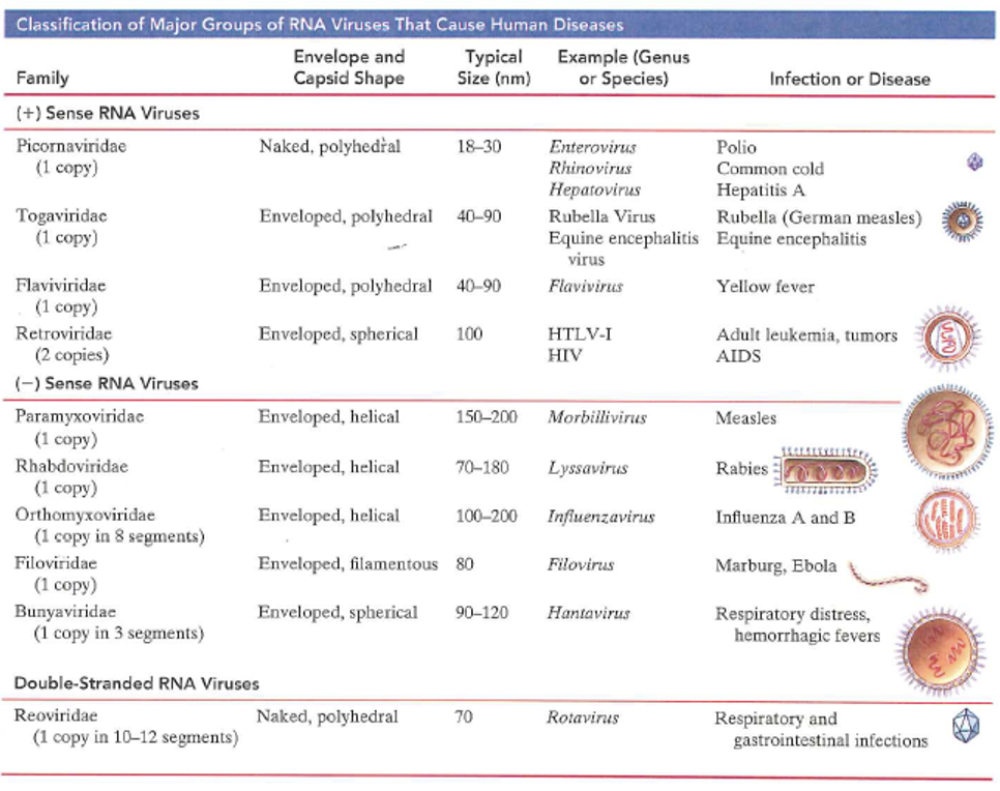
(+) sense RNA viruses
- picornaviridae
- naked, polyhedral
- 18-30 nm typical size
- enterovirus (polio), rhinovirus (common cold), hepatovirus (Hep A)
etc. see picture for all
Classificaions of major groups of RNA viruses that cause human disease
Before Baltimore used classification
+ sense RNA
Picornavirus
- polio (enerovirus), hepatitis A (hepatovirus), common cold (rhinovirus)
flavivirus – yellow fever
- sense RNA
cont.
